

20-Year-Old Hunter S. Thompson’s Superb Advice on How to Find Your Purpose and Live a Meaningful Life. As a hopeless lover of both letters and famous advice, I was delighted to discover a letter 20-year-old Hunter S.

Thompson — gonzo journalism godfather, pundit of media politics, dark philosopher — penned to his friend Hume Logan in 1958. Found in Letters of Note: Correspondence Deserving of a Wider Audience (public library | IndieBound) — the aptly titled, superb collection based on Shaun Usher’s indispensable website of the same name — the letter is an exquisite addition to luminaries’ reflections on the meaning of life, speaking to what it really means to find your purpose.
Cautious that “all advice can only be a product of the man who gives it” — a caveat other literary legends have stressed with varying degrees of irreverence — Thompson begins with a necessary disclaimer about the very notion of advice-giving: Ray Bradbury on Writing, Emotion vs. Intelligence, and the Core of Creativity. By Maria Popova “You can only go with loves in this life.”
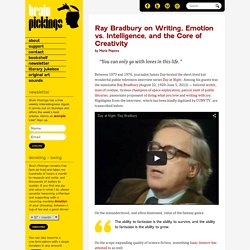
Between 1973 and 1974, journalist James Day hosted the short-lived but wonderful public television interview series Day at Night. Among his guests was the inimitable Ray Bradbury (August 22, 1920–June 5, 2012) — beloved writer, man of routine, tireless champion of space exploration, patron saint of public libraries, passionate proponent of doing what you love and writing with joy. The Evolutionary Mystery of Left-Handedness and What It Reveals About How the Brain Works. By Maria Popova From Medieval sword-fighters to Broca’s brains, or why the hand may hold the key to the link between creativity and mental illness.
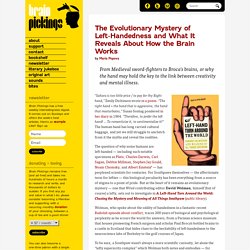
“Sahara is too little price / to pay for thy Right hand,” Emily Dickinson wrote in a poem. “The right hand = the hand that is aggressive, the hand that masturbates,” Susan Sontag pondered in her diary in 1964. “Therefore, to prefer the left hand! How to Be Alone: An Antidote to One of the Central Anxieties and Greatest Paradoxes of Our Time. By Maria Popova. The best relationship advice you'll ever get, what cognitive science reveals about the perfect daily routine and the psychology of writing, and more. Hey Maria!

If you missed last week's edition – Werner Herzog on creativity and making a living of doing what you love, Tolstoy's letters to Gandhi on why we hurt each other, Maya Angelou on courage and facing evil, and more – you can catch up right here. And if you're enjoying this, please consider supporting with a modest donation – every little bit helps, and comes enormously appreciated. The Psychology of Writing and the Cognitive Science of the Perfect Daily Routine Reflecting on the ritualization of creativity, Bukowski famously scoffed that "air and light and time and space have nothing to do with.
" Samuel Johnson similarly contended that "a man may write at any time, if he will set himself doggedly to it. " Ancient Cherokee Indian Tale of the Origin of Illness. Long ago the humans and the animals got along fine.
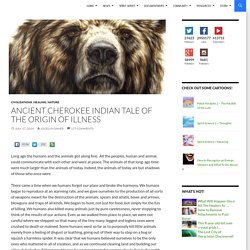
A Short Guide to a Happy Life: Anna Quindlen on Work, Joy, and How to Live Rather Than Exist. By Maria Popova “You cannot be really first-rate at your work if your work is all you are.”

The commencement address is a special kind of modern communication art, and its greatest masterpieces tend to either become a book — take, for instance, David Foster Wallace on the meaning of life, Neil Gaiman on the resilience of the creative spirit, Ann Patchett on storytelling and belonging, and Joseph Brodsky on winning the game of life — or have originated from a book, such as Debbie Millman on courage and the creative life.
How Our Minds Mislead Us: The Marvels and Flaws of Our Intuition. By Maria Popova “The confidence people have in their beliefs is not a measure of the quality of evidence but of the coherence of the story that the mind has managed to construct.”
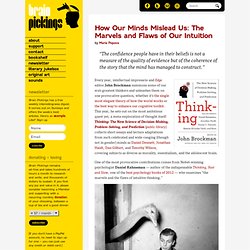
Every year, intellectual impresario and Edge editor John Brockman summons some of our era’s greatest thinkers and unleashes them on one provocative question, whether it’s the single most elegant theory of how the world works or the best way to enhance our cognitive toolkit. This year, he sets out on the most ambitious quest yet, a meta-exploration of thought itself: Thinking: The New Science of Decision-Making, Problem-Solving, and Prediction (public library) collects short essays and lecture adaptations from such celebrated and wide-ranging (though not in gender) minds as Daniel Dennett, Jonathan Haidt, Dan Gilbert, and Timothy Wilson, covering subjects as diverse as morality, essentialism, and the adolescent brain. Networked Knowledge and Combinatorial Creativity.
By Maria Popova Why creativity is like LEGO, or what Richard Dawkins has to do with Susan Sontag and Gandhi.
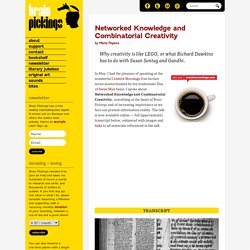
In May, I had the pleasure of speaking at the wonderful Creative Mornings free lecture series masterminded by my studiomate Tina of Swiss Miss fame. I spoke about Networked Knowledge and Combinatorial Creativity, something at the heart of Brain Pickings and of increasing importance as we face our present information reality. Dan Ariely on the Truth About Dishonesty, Animated. You Are Not So Smart: A Field Guide to the Brain’s Guile. By Maria Popova The science of why 600 Facebook “friends” are an illusion, or why brand loyalty is a product of the ego.

How to Master on the Art of Getting Noticed: Austin Kleon’s Advice to Aspiring Artists. By Maria Popova How to balance the contagiousness of raw enthusiasm with the humility of knowing we’re all in this together.
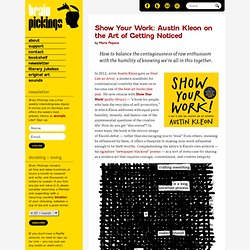
In 2012, artist Austin Kleon gave us Steal Like an Artist, a modern manifesto for combinatorial creativity that went on to become one of the best art books that year. 10 Books for the Creative Soul. Sometimes all you need to get your creative juices flowing is a good read. The quest to find an entertaining, reliable, and genuinely interesting book can be hard, but being the good friends that we are, we did the searching for you. We have compiled a list of some of the most helpful, funny, and creative books out there, ranging from educational content—to doodles that are just fun to look at. Get inspired and take a look at these literary gems. Amazing Food Science Discovery: Edible Plants ‘Talk’ To Animal Cells, Promote Healing. A groundbreaking new study published in Molecular Nutrition & Food Research titled, “Interspecies communication between plant and mouse gut host cells through edible plant derived exosome-like nanoparticles,” reveals a new way that food components ‘talk’ to animal cells by regulating gene expression and conferring significant therapeutic effects.
With the recent discovery that non-coding microRNA’s in food are capable of directly altering gene expression within human physiology,[1] this new study further concretizes the notion that the age old aphorism ‘you are what you eat’ is now consistent with cutting edge molecular biology. Exosomes: The ‘Missing Link’ In How Plants and Animal Cells Communicate and Collaborate This is the first study of its kind to look at the role of exosomes, small vesicles secreted by plant and animal cells that participate in intercellular communication, in interspecies (plant-animal) communication. The New Study Plant Exosomes Affect Mammalian Cells Intimately. I am, because of you: Further reading on Ubuntu. Ubuntu (philosophy) Ubuntu (/uːˈbʊntuː/ oo-BUUN-too; Zulu/Xhosa pronunciation: [ùɓúntʼú]) is a Nguni Bantu term (literally, "human-ness") roughly translating to "human roughness.
" It is an idea from the Southern African region which means literally "human-ness," and is often translated as "humanity towards others," but is often used in a more philosophical sense to mean "the belief in a universal bond of sharing that connects all humanity".[2] In Southern Africa, it has come to be used as a term for a kind of humanist philosophy, ethic or ideology, also known as Ubuntuism or Hunhuism (the latter after the corresponding Shona term) propagated in the Africanization (transition to majority rule) process of these countries during the 1980s and 1990s. Since the transition to democracy in South Africa with the Nelson Mandela presidency in 1994, the term has become more widely known outside of Southern Africa, notably popularized to English language readers by Desmond Tutu (1999).
Stanlake J. W. Baruch Spinoza. How Fasting Fights Cancer. Welcome! If you want to lose weight, gain muscle, increase energy levels or just generally look and feel healthier you've come to the right place. Here's where to start: Visit the Start Here and Primal Blueprint 101 pages to learn more about the Primal Lifestyle. Subscribe to my free weekly newsletter to receive 10 eBooks, a 7-Day Course of Primal Fundamentals, and more - all for free.
Cut to the chase by visiting PrimalBlueprint.com. Thanks for visiting! “Everyone has a physician inside him or her; we just have to help it in its work. 2. How values work. How Fasting Fights Cancer. Debunking the Myth of the 10,000-Hours Rule: What It Actually Takes to Reach Genius-Level Excellence. By Maria Popova. Fail Safe: Debbie Millman’s Advice on Courage and the Creative Life. By Maria Popova. The Architecture of Happiness: Alain De Botton: 9780375424434: Amazon.com. Art as Therapy: Alain de Botton, John Armstrong: 9780714865911: Amazon.com. 100 Ideas That Changed Art. By Maria Popova From cave paintings to the internet, or how art and cultural ideology shape one another. On the heels of yesterday’s 100 Ideas That Changed Photography comes 100 Ideas That Changed Art (public library) — a succinct account of the most influential developments in the history of art, from cave paintings to the internet, compiled by art historian and broadcaster Michael Bird.
From conceptual innovations like negative space (#98), color codes (#33), and street art (#94) to landmarks of communication like making books (#21), propaganda (#12), and handwriting (#24) to ideological developments like “less is more” (#30), protest (#79), and the body as surface (#9), each idea is contextualized in a 500-word essay with key visual examples. How We Spend Our Days Is How We Spend Our Lives: Annie Dillard on Presence Over Productivity. By Maria Popova. The Art of Looking: What 11 Experts Teach Us about Seeing Our Familiar City Block with New Eyes. By Maria Popova “Attention is an intentional, unapologetic discriminator. Salvador Dalí’s Rare, Erotic Vintage Cookbook. By Maria Popova.